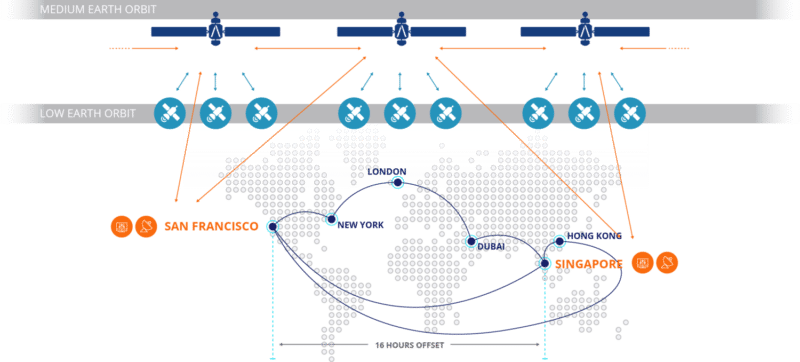Space-Based Internet: Will Audacy Change the Game?

The architecture of Audacy’s three satellite network. Photo: Audacy.
It’s the cornerstone of business: see a need, fill this need. The more you understand the needs of your customers, the more business you can get, because need determines demand and price, and right there is the crux of your enterprise. The only thing that matches a good need and being able to meet it, is being able to supply what people want irrespective of need. Not sure if this is true? Think about coffee, chocolate or even data. It is here that the line separating need and want becomes blurred; what is important is that we just got to have it.
If being in the business of selling what people need is good, then how do we describe being in the business of selling what people must have? Chocolate, caffeine and data – many would admit an addiction to one or more of these. A business built around this is surely destined to be audacious. And this is how Ralph Ewig, Chief Executive Officer (CEO) of Audacy, sees it. With the U.S. Federal Communications Commission (FCC) having authorized a spectrum license earlier this month, allowing the Silicon Valley startup to operate its inter-satellite data relay network, Ewig sees a bold future.
“Audacy is an enabler for everyone with plans to deploy assets in space. We’re creating the first commercial inter-satellite network in human history; providing truly global coverage at an affordable price that enables the entire industry to do more, while connecting human space activities in real time with everyone back on Earth. Audacy is essentially building the internet in space, and there is no limit to what you can do with that,” he said.

Audacy architecture. Photo: Audacy.
Securing the FCC license is a strong validation of Audacy’s business model to potential investors, and demonstrates regulatory support of its goals as an enabler to the entire industry, Ewig said. Audacy has accelerated its pace of development, is now actively raising its Series B financing, and intends to triple the size of its team by the end of this year. Additionally, Audacy has two demonstration missions launching in 2018, Audacy Zero and Audacy Lynq, that will provide valuable data on its client terminal design, while also enabling it to commission its ground teleports and network infrastructure.
The FCC grant adds to the momentum already gained in the customer department. According to Ewig, to date, the company has engaged with a number of operators with success. With the opening of its Singapore office last year, Audacy has increased its exposure in the Asia-Pacific region, and significantly increased customer traction in this market. Audacy is already closing contracts for capacity on its network, combining both ground and space assets. The ground teleports will be available for commercial use early next year, and the relay satellites will enter commercial service in 2020.

Ralph Ewig, Chief Executive Officer (CEO) of Audacy.
“Customer traction as measured by the number of customers and total value in signed agreements has exceeded our original projections by a significant margin. In fact, the success we’ve had on the business side prompted us to rethink certain aspects regarding our architecture. Based on this strong interest, we were able to secure a commitment from our investors to build a larger initial system than originally planned, roughly doubling the mass and nearly tripling the total capacity of our relay satellites over the previous design,” said Ewig.
Due to insight gained last year, the company has been able to change its approach and is not only able to meet today’s customer needs, but also accommodate them as they evolve.
“A true always-on baseline capability for spacecraft monitoring and control is the gateway to entry. A high data rate that’s available only sometimes, or under very specific circumstances cannot serve as a mission critical foundation to operate a spacecraft. As a low throughput capability was achievable with a smaller initial investment, we adopted an incremental approach: getting our service off the ground with low data rate applications, then deploying larger satellites in the second generation to bootstrap the business from that revenue into the higher data rate markets,” explained Ewig.
Audacy has changed this approach to offer higher data-rate services on top of the always-on entry point. It can then grow capacity in the future by adding more satellites of the same design, rather than larger ones. This allows the company to spread the development cost over a larger fleet using incremental improvements.
“It also opens up new market segments. Customers with data intensive applications who previously settled for using a ground-based solution and waiting until a space-based alternative became available, can now achieve much higher data returns at an earlier date — exceeding 40 Terabits per day. It’s a win on all sides,” said Ewig. “Our customers have already surprised us with new business models built upon the capability of always-on, real-time space communications. Once a space operator decides to leverage Audacy to their advantage, competitors have no choice but to follow suit to remain relevant. This points to continued growth in demand into the foreseeable future, and we’re tremendously excited to support this expansion of human space activities for the benefit of everyone on Earth.”
Verticals to be greatly impacted by Audacy include launch vehicle operations, Internet of Things (IOT) constellation management, and human spaceflight. While any application of spacecraft in Low Earth Orbit (LEO) would benefit from 100 percent connectivity, Audacy extends this to as far as lunar distances.
“Earth observation companies also make up a sizable chunk of our prospective customers. This market may have started with optical imaging, but is now branching out into many variations from Synthetic Aperture Radar (SAR), to hyperspectral, or even HD video. All of these new applications are very data intensive, and with Audacy, operators can focus their system design resources on the payload component rather than the communications subsystem,” added Ewig.
Audacy is fully engaged with companies along the entire value chain of Earth observation and not just the operators that own satellites, but also analytics companies that purchase the data for interpretation and resale.
“We consistently hear the same message: the closer to real time the information is, the better. We are a society that expects ‘instant everything,’ and technology development cycles and decision making are no exceptions. Until now, the time scales of space activities have been measured in decades. With Audacy, we’re talking milliseconds — it’s a game changer,” Ewig said.